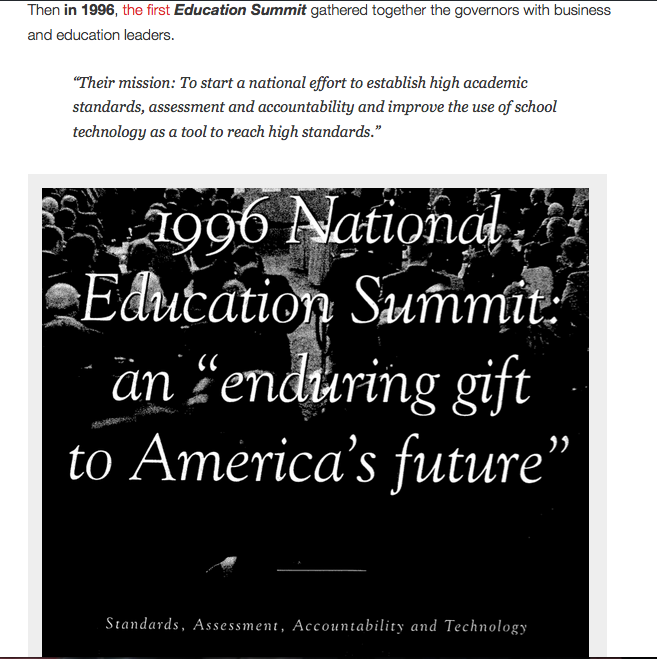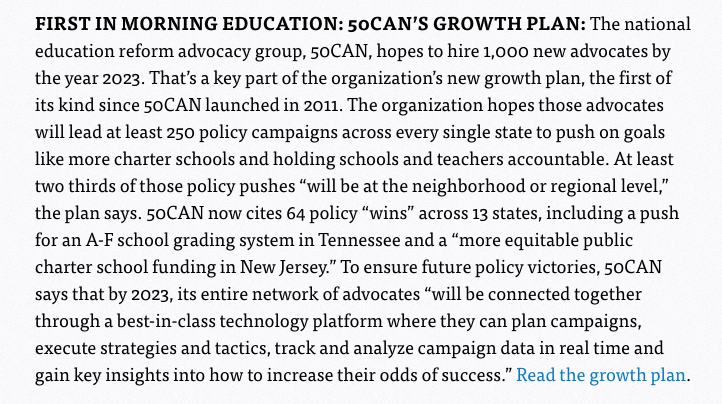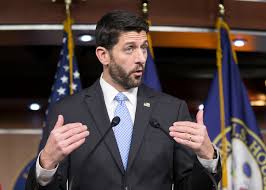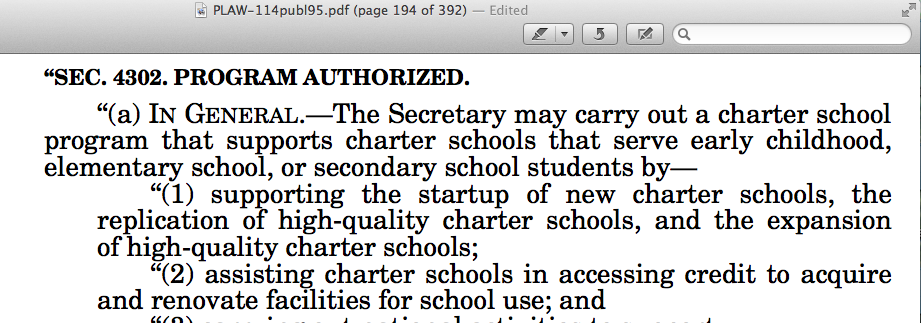Tag Archives: school choice
A Clear Plan: The Revolution in School Policy
The National Governor’s Association (NGA), corporate leaders, foundations and other special interest groups advanced a clear plan to use the rise of the Information Age to float the economy. Their vessel? Our public education system.
Necessary or not, the school policy revolution began.
1969 — 75% of parents sampled (PDK/Gallup) said they would like to see one of their children teach in a public school.
1979 — 86% of parents with children 13 years and older had no desire to send their children to a different public school.
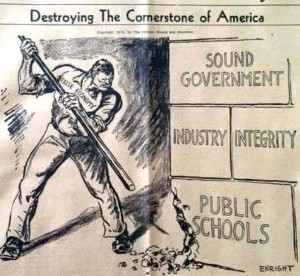 1983 — Governor Lamar Alexander created TN’s “Better Schools Program,” which put a merit pay system (pay for performance/career ladder) at the heart of the plan.
1983 — Governor Lamar Alexander created TN’s “Better Schools Program,” which put a merit pay system (pay for performance/career ladder) at the heart of the plan.
The hook: the idea of “flexibility” in exchange for “results.”
The pretense of accountability in an outcome-based (pay-for-results) system was launched ahead of the Reagan administration’s report A Nation at Risk.
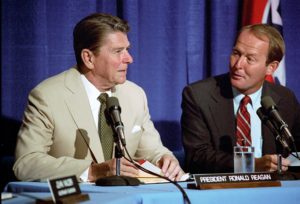
6-14-1983 President Reagan participating in a Regional Forum on the National Commission on Excellence in Education Report with Governor Lamar Alexander at the Farragut High School in Knoxville, Tennessee
The Test-Based Accountability Ship Sailed
Demand for testing needed to be created but a couple of barriers stood in the way — local control and an established and effective education system. So a clear plan to take over school policy needed to begin with a strategy to undermine the public’s trust in the institution of public education. This was known:
Parents know a good deal more about the schools … than nonparents. They are heavily influenced by firsthand knowledge, whereas the opinions of nonparents derive more often from the media,… (PDK/Gallup 1984)
The larger voting block — non-parents — became the first target for an information campaign.
1986:
“When the Carnegie Forum Task Force began its work, we knew that the Governors were the key to the necessary revolution in school policy.”
Marc Tucker —1986— then executive director of the Carnegie Forum on Education and the Economy
With Governor Lamar Alexander chairing the NGA, they released a report titled Time for Results.
The Reagan administration supported the clear plan to support the education industry.
“What is industry in a knowledge-based economy?” The answer is the education industry.
Lewis Branscomb —1986— IBM Chief Scientist, Head of Carnegie Foundation Task Force on Teaching
The education industry would profit from two main concepts, outcome-based education and “school choice.” But the establishment of national standards were essential for industry “efficiency,” or to reach “economies of scale” (higher return on investment). National standards provided a national foundation for large-scale operations.
The Course was Set: “Education Reform.”

This project was under the direction of Secretary of Education William (Bill) Bennett with assistance from his political bedfellow, Governor Lamar Alexander.
1987 — With Governor Alexander navigating both state and federal policy waters, the governors floated projects in several states with 1991 as the target date for reporting the results. Supposedly “the results” would determine if these “real reforms” should be scaled-up nationwide. Trustworthy analysis was crucial.
It appeared that our national research and development system—Regional Education Laboratories— put in place under the 1965 Elementary and Secondary Education Act (ESEA) — would be central to that research.
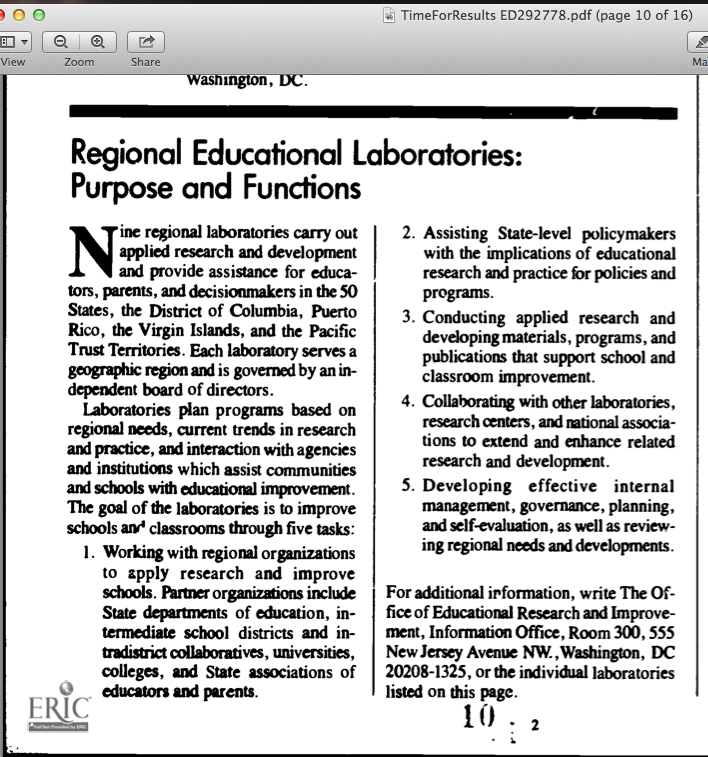
In addition to our Regional Educational Laboratories, the Research and Development (R&D) Centers are also part of our U.S. R&D system.
1988 — Before leaving office, Reagan signed the Hawkins-Stafford Amendments to ESEA.
Including: “requirements regarding accountability evaluation of programs conducted in accordance with national standards to be developed by the Department of Education.”
Boundaries Were Crossed
That policy change took ESEA from a law that prohibited any federal influence over curriculum and instruction to placing evaluation of programs associated with national standards under the direction of the Secretary of Education. Not just schools, but the whole governing structure of schools was to be restructured, not just reformed.
“Restructuring” Schools: Creation of the School to Workforce/Military Pipeline
1989—Marc Tucker advised President-elect Bush about the education restructuring efforts underway by businesses and the NGA.
Tucker’s own organization, National Center on Education and the Economy (NCEE), created the National Alliance for Restructuring Education (NARE) to promote Standards-Based Education. And…
… privately, an education summit was planned. New NGA chairman, Terry Branstad, hoped “the focus of the meeting would be on tailoring our education system for the workforce of the future.”
The first (invitation only) National Education Summit was held for the president with governors, business leaders, and a few representatives.
A joint statement confirmed that the setting of national goals and the development of “a system of accountability that focuses on results” had been agreed to.
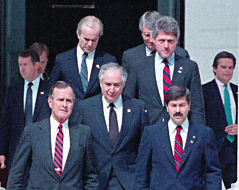 1990— Tucker’s (NCEE) publication of “America’s Choice” continued the push for policies to focus on output measures (hear Tucker explain beginning at minute 33:30) as Governor Bill Clinton summarized …
1990— Tucker’s (NCEE) publication of “America’s Choice” continued the push for policies to focus on output measures (hear Tucker explain beginning at minute 33:30) as Governor Bill Clinton summarized …
“We need a national exam, measured by international standards, and the continued development of a quasi-governmental institution.”
A Quasi-Governmental Institution? As that sinks in, please keep reading.
1991— President George H.W. Bush appoints Lamar Alexander as his second Secretary of Education.
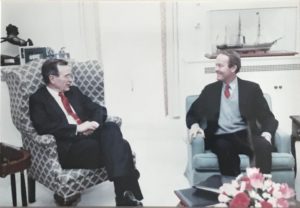 With Alexander in charge, and his Office of Educational Research and Improvement (OERI) being the “lead agency” for research, the nation should have heard results from Project Education Reform: Time for Results. Instead, the nation got a report card.
With Alexander in charge, and his Office of Educational Research and Improvement (OERI) being the “lead agency” for research, the nation should have heard results from Project Education Reform: Time for Results. Instead, the nation got a report card.
The results? This New York Times reporter gives us some clues about Alexander’s strategies and the results.
“…disappointingly superficial on the issues…
“He resists detailed debate …”
“…and the program he’s got is not a winner, …”
The Alexander agenda included national standards and testing, teacher merit pay, change through competition, and “choice.”
The “Education Council Act of 1991” established a temporary 32 member council — National Council on Education Standards and Testing (NCEST) — “most of whom were appointed by the Secretary of Education.”
1991 also marked the nation’s first voucher legislation (proposed by Secretary Alexander).
1992 —No surprise. NCEST recommended national standards and testing. But it was without answering some important questions and …
“NCEST does not explain why the proposed tests will not narrow the curriculum.” Daniel Koretz & Others
1992— President Bush lost his re-election bid to Bill Clinton.
Marc Tucker penned his infamous November 11, 1992 letter to Hillary Rodham Clinton.
“Tucker’s plan would change the mission of the schools from teaching children academic basics and knowledge to training them to serve the global economy in jobs selected by workforce boards.” Thinker, RealistNews
Presidents Changed: The Politically Powerful Continued the Policy Journey
“To remold the entire American system for human resources development.” Marc Tucker
1993— D.C. think tank “Empower America” was co-founded by former Reagan Education Secretary William (Bill) Bennett.
Empower America philosophy: “…opportunity, competition, ownership, and freedom—must be the framework for reform of century-old public systems such as K-12 education, the tax code, and social security.”
1994— President Clinton signed the “Improving America’s Schools Act” (IASA).
Clinton’s ESEA reauthorization -IASA;
- mandated accountability based on grade-span (3rd,8th,11th) standardized testing,
- called for content standards to be set by ALL states, and
- added funding for charter schools into ESEA for the first time.
Meanwhile, Lamar Alexander became a co-director of Empower America.
“We’re planning on [Mr. Alexander] coming back and being a part of a big school-choice initiative.” Empower America
1996-2002 — The school policy revolution shifted to state efforts to expand outcome-based accountability mechanisms (exit-standards testing) and charter schools.
Remember, industries were counting on public education money and governors were always key to the “necessary” school policy revolution.
“The role of the governors … was crucial because they mobilized the public and legislators in their states to support educational reforms.”
The Technology Industry Took the Helm
1996 — The Education Summit, as the story goes, gave birth to the Gates’ supported Achieve, Inc.
1997 — Lamar Alexander & Bill Gates addressed the NGA. Alexander mused about how after all the years of governors “leading the charge” and pouring money into “their plan,” charters and standards had not improved education.
1998 — Tucker’s NCEE created the “America’s Choice School Design Program” (later purchased by Pearson Inc.).
1999 — Tucker’s NCEE launched the National Institute for School Leadership (NISL) and Bill Gates launched the “Gates Learning Foundation.”
NCEE was asked by Carnegie Corporation, joined by the Broad Foundation, the Stupski Foundation and the New Schools Venture Fund, to create a design for a new kind of national organization to train school principals to lead high performing schools.
Time to Drop Anchor on The Nation
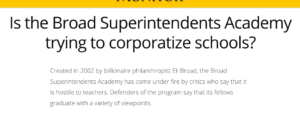
2002: The Broad Academy was founded. Source: The Christian Science Monitor
2002 — The 2001 President George W. Bush’s ESEA reauthorization, No Child Left Behind (NCLB) went into effect.
Among other things, NCLB:
- expanded standardized testing to yearly (3rd-8th grade and once in high school),
- required ALL students be “proficient” on state tests by the 2013-14 school year,
- promoted and assisted states in “enhancing” achievement through technology,
- expanded “school choice” through a variety of programs (Clinton era – $15 Million expanded to $214.8 Million by 2007. Now, FY2018 $1.4 Billion “for public & private school choice opportunities” ),and NCLB
- allowed access to student data for military recruiters.
In addition to NCLB’s passage, the Education Sciences Reform Act of 2002 changed the federal system of research, development and dissemination of educational practices by created Comprehensive Centers (Regional and Content Centers).
Failure to get results from standards (Outcome-Based Theory) and “choice” had been blamed on being “too timid,” the addition of federal CENTERS worked to more aggressively implement the agenda. Instead of functioning to meet regional needs like the Regional Educational Laboratories originally did, these centers are being used to “provide frontline assistance.” For example, they were used to implement the Common Core Initiative, an initiative designed and controlled by a quasi-governmental organization.
Last but not least of the 2002 policy anchors, the Educational Technical Assistance Act of 2002 established the Statewide Longitudinal Data Systems (SLDS).
Full Speed Ahead
2003 — Lamar Alexander began his senate career.
2005 — Having been recognized as the most influential person in School Policy, Bill Gates co-chaired the National Education Summit.
2006 — The Data Quality Campaign (DQC) Launched at the Data Summit.
The campaign promoted the Gates’ “ten essential elements” of a longitudinal data system, which included the ability to match student records between the Pre-K and post-secondary systems.
2007 — NO CHILD LEFT BEHIND should have been left behind. (ESEA review & reauthorization IS required every 5-6 years, by law.) NCLB remained anchored in place while common standards and assessments were being “piloted.”
2008 — Idaho was the last state to complete a statewide longitudinal data system with all the elements required by Gates’ DQC.
Meanwhile, unofficial “reports” declared an educational crisis in cities while the Great Recession disrupted the nation.
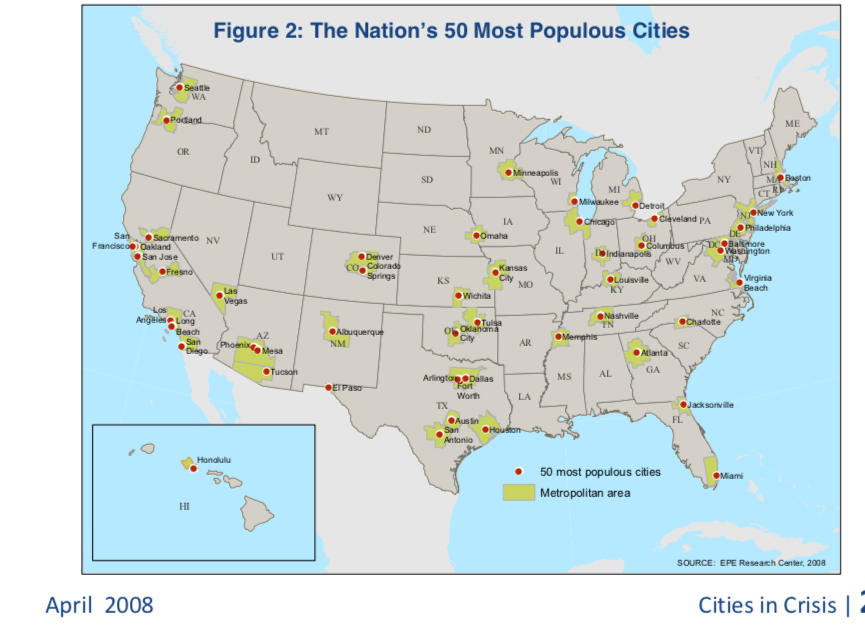
For me, this map represented the War Plan. I watched as city schools and family’s lives were disrupted with school closures. This “report” was prepared with support from America’s Promise Alliance and the Bill & Melinda Gates Foundation
The Race Begins
2009 —Oh what a year! 43 percent of all large urban superintendent openings were filled by Broad Academy graduates.
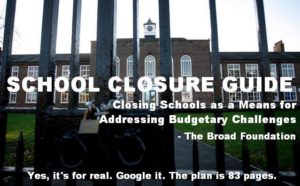
In the Education Reform Toolkits by The Broad Foundation.
The American Recovery and Reinvestment Act of 2009 went into effect and the quasi-governmental institutions went to work on spending those funds.
Race to the Top began: “And finally, for the first time in history, we have the resources at the federal level to drive reform.”
Bill Gates explained at the National Conference of State Legislatures (NCSL) that a thorough data collection system is the best way to track student success.
2010 — Common Core became a common problem.
The Workforce Data Quality Initiative began granting federal money to connect education and the workforce data.
 2011 — The undercurrent of revolt against outcome-based policies —high-stakes testing and the “accountability” systems based on them— began to surface. The resistance organized; we marched and we met.
2011 — The undercurrent of revolt against outcome-based policies —high-stakes testing and the “accountability” systems based on them— began to surface. The resistance organized; we marched and we met.
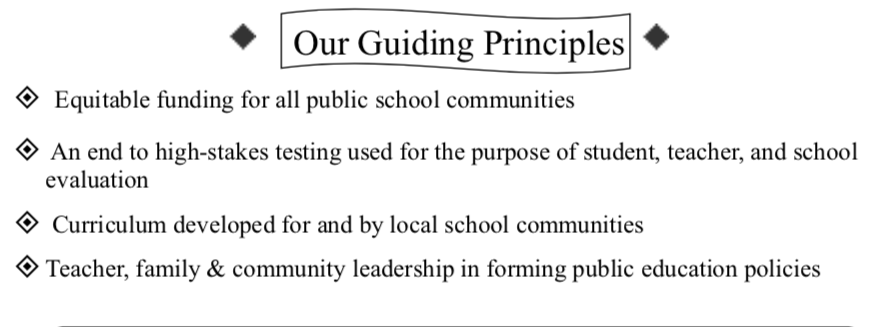 2012 —The Obama administration called for Congress to “reform NCLB” but instead the nation got accountability waivers in exchange for adoption of “more honest standards.” Honestly, “college and career ready standards” meant the Common Core standards.
2012 —The Obama administration called for Congress to “reform NCLB” but instead the nation got accountability waivers in exchange for adoption of “more honest standards.” Honestly, “college and career ready standards” meant the Common Core standards.
2013 — The NCLB replacement the “Every Child Ready for College or Career Act” was introduced by Senator Alexander.
2014 — Revolts against the college, career and military ready Common Core National Standards grew.
2015 — Lamar Alexander took over the chairmanship of the Senate education (HELP) committee and introduced a new name for the NCLB replacement, “The Every Child Achieves Act,” which later became the Every Student Succeeds Act (ESSA) we now have as our ESEA reauthorization. Is ESEA better than NCLB? You decide.
The flaws in No Child Left Behind remain. The funding for testing, technology and school choice are increased.
Clear Sailing to the Finish Line of the Revolution in School Policy
?
The finish line? A quasi-governmental organization controlling common national standards and testing with all data collection and consolidation in a single office for use in the Workforce Placement System.
A “computer-based system for combining this data” was always central to the Tucker Education-Labor System Plan.
The Foundations for Evidence-Based Policymaking passed as HR 4174 (sponsored by Speaker Paul Ryan) but its identical sister bill was sponsored by Gates’ Washington State Senator Patty Murray.——–2019——–signed into law by President Trump.
This “honestly” is a bipartisan revolution in school policy
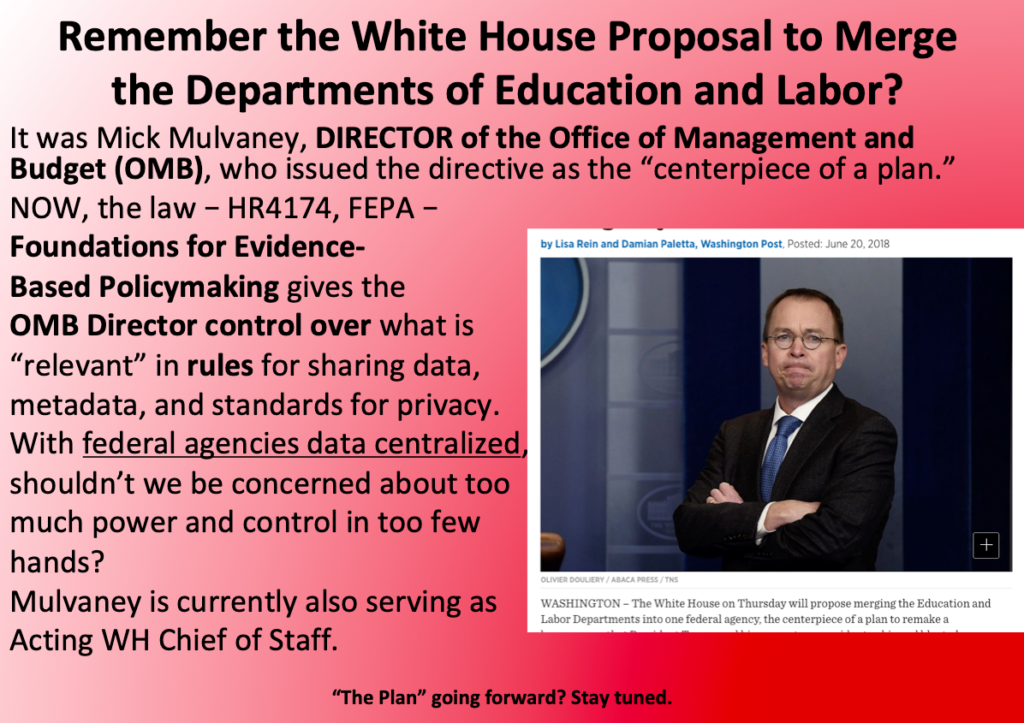 The Outcome of the School Policy Revolution?
The Outcome of the School Policy Revolution?
54% of Americans say they would NOT want their child to become a public school teacher, a majority for the first time in a question initially asked in 1969.
70% of parents still give their oldest child’s school an A or B grade.
The Republic? Creeping or Leaping Towards Totalitarianism.
Lamar Alexander has consistently claimed to support “local control,” but what is left to control?
#####
For those requiring more proof of these historical events, more detailed of educational results, or the references not already provided, please review (and download for free) the journal article Assessing the Cornerstone of U.S. Education Reform.
Zombie Ideas Are Killing Public Education
“Zombie ideas … are policy ideas that keep being killed by evidence, but nonetheless shamble relentlessly forward, essentially because they suit a political agenda.” Paul Krugman
Zombie Ideas!?!
Exactly! … Policymakers have been using zombie ideas to dismantle, transform, and restructure the public education system. But there is a mountain of evidence that the zombie ideas in No Child Left Behind didn’t show any appreciable improvement in student achievement. So why not end the zombie invasion killing our public schools, now?
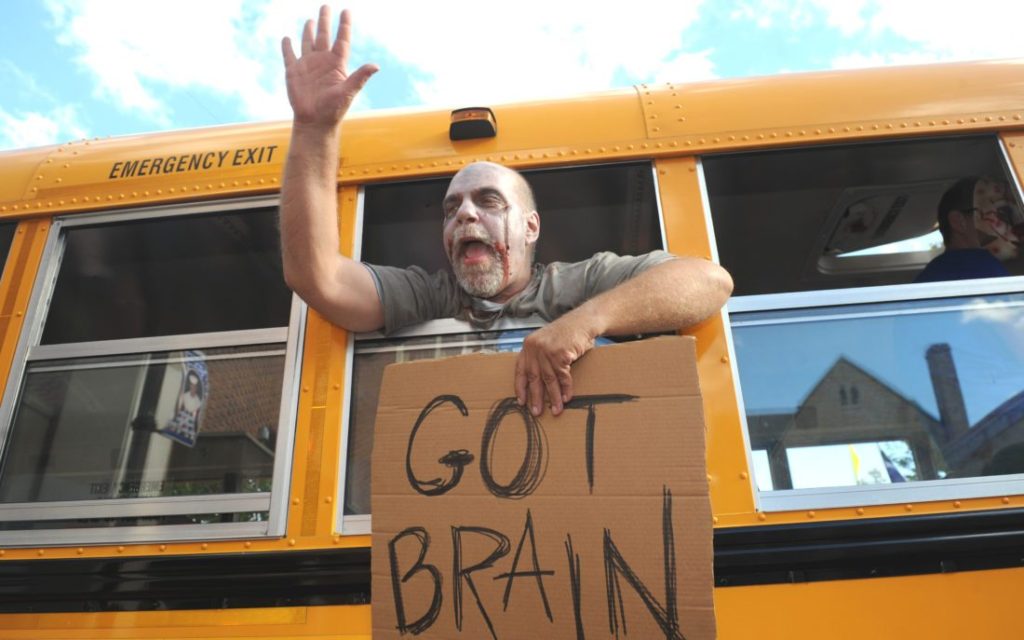
Zombie ideas are hard to kill because they have already been killed by evidence! Mirror photo by Gary M. Baranec
What Zombie Ideas?
The test-based, metric-driven accountability of the No Child Left Behind (NCLB) law is based on a political agenda, not proven education reforms. Now, NCLB is called the Every Student Succeeds Act (ESSA) but the same policy ideas and political agenda remain in place. The same detrimental consequences persist because the aim and purpose of the law did not change.
Zombie Ideas in Education: High-Stakes Testing and Graduation Policies*
Solórzano (2008) found that the results of high-stakes tests used as a high school diploma requirement “show quite clearly that Blacks and Latinos (and English Language Learners) are disproportionately failing them, whether enrolled in Texas, New York, California, or Minnesota” (p. 312).
He goes on to say that students who do poorly on these exams “are viewed as the problem; they are retained, tracked, or denied graduation” (p. 316) and cites several sources for this statement.
Then, comes the most logical and obvious, yet often negated fact of this matter: “They are held solely responsible for their grades, when in fact, they may not have had equal chance of learning because of the unequal resources and opportunities at their disposal at their school site” (p. 316).
The policy of high-stakes testing that has led to multiple incorrect, unethical, and detrimental uses of test results is just one example of a zombie idea that needs to die —permanently.
Other Zombie Ideas That Just Won’t Die!
Choice and competition are market-based ideas whose theories have been applied to public education to transform and restructure our public system into a privatized system. So based on the idea of school choice as a reform, researchers** examined student achievement under this Market Theory — with the demand side being “school choosers” and the supply side being schools. They did so while also cautioning that psychologists are well aware of the effect of “choice.”
Theory On the Demand Side:
“The simple act of choosing a school then might contribute to a family’s satisfaction with that school.”
Theory On the Supply Side:
“Decentralized decision-making itself might be beneficial to students. … This local control could lead to more efficient, locally appropriate use of resources, better alignment and camaraderie among the school personnel, and improved responsiveness to opportunities and challenges.”
But Overall:
“While there are isolated (and sometimes very impressive) success stories, school choice reforms have not proven to be unambiguously effective on the whole.”
Charter or Voucher: It Doesn’t Matter
“Much like the charter school literature, the literature on private school vouchers does not conclusively link the use of vouchers to improved academic performance.”
Existing Public Schools are Forced to Compete: True
“While most principals report competing for students, few report that they compete by making curricular or instructional changes that might appeal to parents. Instead, they are considerably more likely to report competing through outreach and advertisement.”
Choice and competition are zombie ideas that increase return on investment to the education industry — and the cottage industries of marketing, data analysis, and advertising. School choice is not a systemic reform. It is a market theory that doesn’t tackle the solutions we should focus on — those that strengthen and improve educational quality and opportunity FOR ALL CHILDREN.
Rising from the Depths of the Swamp: More Zombies or Real Reform?
While the political agenda behind the zombie ideas focuses the nation’s attention on “outputs,” the idea of focusing reforms on “inputs” keeps getting buried alive. Even though it is logical and obvious that learning requires specific inputs, that poorer communities have fewer resources, and that the schools that struggle to provide better education are located in areas of concentrated poverty — our laws remain fixed on Outcome-Based (output) Theory.
While federal and state lawmakers continually mandate higher learning standards, “service delivery standards” remain buried in history.
Yes, it is true. Once upon a time America saw educating its youth as a public service. We were going to set a quality standard for delivering that service. While we still hear the phrase “Opportunity-to-Learn Standards,” those pushing their political agenda to privatize the system kill that conversation. Their actions say they don’t care about all the nation’s children. If those in power really cared, they would have pushed for “service delivery standards” to support local school improvements.
Instead of bad policy ideas being killed by evidence, those with a political agenda are killing the public education system.
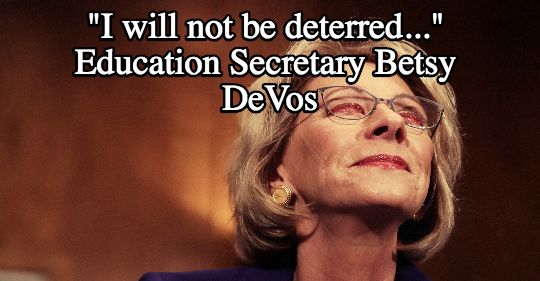 Zombies are hard to kill because they are already dead. But it seems to be common knowledge that to kill a zombie you must destroy its brain.
Zombies are hard to kill because they are already dead. But it seems to be common knowledge that to kill a zombie you must destroy its brain.
These zombie reform ideas —high-stakes testing, metric-driven centralized accountability, competition through charters and vouchers — don’t die because they serve a political agenda. It is the “brains of the operation” that we must expose and politically destroy.
Sources:
*Kern, Diane. Zombie Ideas in Education: High-Stakes Testing and Graduation Policies. New England Reading Association Journal 49.1(2013): 96.
**Loeb, S., Valant, J., Kasman, M., Increasing Choice in the Market for Schools: Recent Reforms and their Effects on Student Achievement. Forum on the Education Reform in an Era of Fiscal Imbalance. National Tax Journal, March 2011, 64 (1), 141–164.
The Fierce Urgency of Now
Spoken by Martin Luther King and repeated often, do the words “the fierce urgency of now” no longer stir our souls? Did they ever?
Why the Urgency NOW?
The urgency is the need for all of us to filter out the divisive political language coming at us from all sides. In this moment, we need to look back at what was once only a theory. Now our reality is that economic theory fostered a political strategy to supplant our constitutional republic with “a private governing elite of corporate power.” *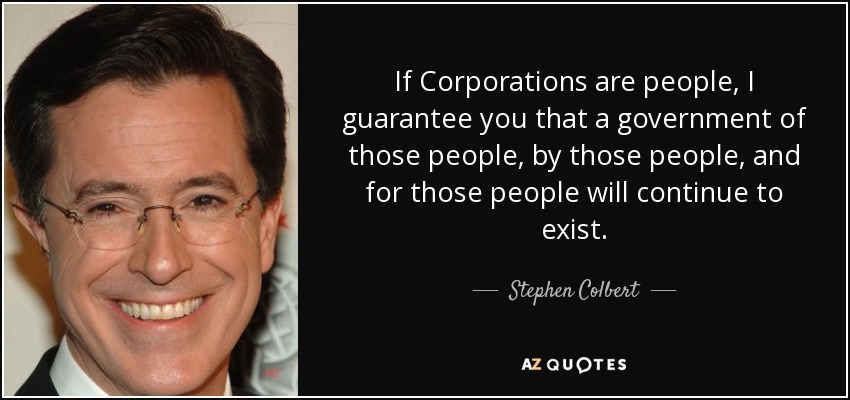 Those pushing corporate control understand how essential it is for them to …
Those pushing corporate control understand how essential it is for them to …
“…kill public education because it tend[s] to foster community values…” *
And market-based education reforms became the weapon of choice. But the role of political economist James M. Buchanan is only now being closely scrutinized. Buchanan’s theories explain much about the divisiveness destroying our schools and our nation.
“…[Buchanan] observed that in the 1950s Americans commonly ASSUMED that elected officials wanted to act in the public interest. …[T]hat was a belief he wanted, as he put it, to ‘tear down.’ His ideas developed into a theory that came to be known as ‘public choice.’” *
Public Interest vs. Public Choice
Public interest is defined as “the welfare or well-being of the general public.” It is a national goal clearly stated in the Constitution’s preamble — “in Order to … promote the general Welfare…”.
To “tear down” our assumption that officials are acting in the public’s interest is one thing. To destroy our union is another. That goal does NOT appear to be one of the aims of Buchanan’s original 1986 Nobel Prize winning work on “Public Choice Theory.”
In its announcement of the prize, the Royal Swedish Academy of Sciences noted, “Buchanan’s foremost achievement is that he has consistently and tenaciously emphasized the significance of fundamental rules and applied the concept of the political system as an exchange process for the achievement of mutual advantages.” Tennessee Encyclopedia (James McGill Buchanan)
His “research program” ** centered on the belief that people make purchases (market choices) based on value. He saw the public making political choices they believed would benefit them. He viewed us as making choices based on our own “venal self-interest.” *
So he and his ilk developed what they called “non-market decision-making.” Finding that name “awkward” and not as appetizing to “free-market” thinkers, the groups’ organization and publications took on the name “Public Choice.” **
Choice or Coercion?
Some researchers believe that Buchanan’s Public Choice Theory began as an “optimistic conception” based on “unanimous consent of the people.” But he later adopted a more “pessimistic view” about “social organization” and people’s “intolerance” to entering into the discussions necessary to reach consensus on issues. Thus Buchanan’s emphasis morphed from “individual freedom” to the need to “enforce order.” ***
As Buchanan explained “Public Choice” to an audience (2003) …
“Public choice, in its basic insights into the workings of politics, incorporates an understanding of human nature that differs little, if at all, from that of James Madison and his colleagues at the time of the American Founding.” **
Buchanan wrote that for public consumption. It’s a distortion of history, which is likely being perpetuated through institutions such as George Mason University in Virginia.* And in misrepresenting the American Founding Principles, Buchanan opened himself up to being viewed as a major manipulator in our historic fight against corporate control.
James Madison vs. James Buchanan
As a key author of the Constitution, Madison left a record of discussions about our nations founding principles. Therefore, a better understanding of the American Founding political views can be gleaned from Madison’s correspondence with a colleague who Buchanan also admired. ***
James Madison to Thomas Jefferson, 17 October 1788 (The Papers of Thomas Jefferson, Julian P. Boyd, ed., vol. xiv, pp. 18-21) …
“With regard to Monopolies, they are justly classed among the greatest nuisances in Government. … Monopolies are sacrifices of the many to the few. Where the power is in the few it is natural for them to sacrifice the many to their own partialities and corruptions.”
Madison went on to express his doubts about a government takeover by monopolies being skeptical …
“…that a succession of artful and ambitious rulers may be gradual & well timed advances, finally erect an independent Government on the subversion of liberty. … Is there not also infinitely less danger of this abuse in our Government than in most others? … with the power as with us is in the many … It is much more to be dreaded that the few will be unnecessarily sacrificed to the many …”
It appears the expressed sentiment of that last sentence was taken to imply that corporations are the ones in need of constitutional protection from the masses. But Buchanan obviously took Madison’s words out of their historic time and context. Regardless, Buchanan did communicate to the public an association of his “public choice theory” with our nation’s founding principles.

****This quote is from the blog of libertarian economist, Daniel J. “Dan” Mitchell who believes Buchanan’s ideas are being misrepresented.
Same Old Fight: Big vs. Smaller Government?
Not Quite! Think about the following in relationship to the privatization of public education through “school choice” models. The allure of choice is deadly.
With our political choices being analyzed under market-based economic theory, it is assumed people make choices based on their own self-interests — first and foremost. We shouldn’t deny that as a truism. But when market forces —of privatized PUBLIC services or goods— come into play, competition for a limited supply will result in winners and losers. Always does.
We risk having children lose, or never develop, the safe and secure sense of belonging that defines “community values.” When all of us are seen as “self-interested players in the marketplace,” **** we are vulnerable to division. Competition for public services runs the high risk of destroying community values, but that part of the equation didn’t seem to garner much consideration.
Instead, Buchanan saw the need to bring his vision to life by NOT focusing on who rules because who the public chooses doesn’t matter since elected officials don’t act in the public interest anyway. Therefore, this political economist focused on the rules themselves.
“… the Holy Grail was the Constitution: alter it and you could increase and secure the power of the wealthy in a way that no politician could ever challenge.” *
“Subversion of Liberty”? Translation: Sabotage of Authority
What Madison saw as improbable under our constitutional republic — “a succession of artful and ambitious rulers” changing the balance of power — is exactly what is happening. Our federal government IS under the control of special interests. Many state governments are no different because too many of our representatives ARE no longer serving in the public interest.
The toxic divisiveness of party politics is permeating our communities. The principles of localism and populism, which formed the fabric of our founding documents, are being replaced by corporatism. Thus, when we can no longer reach consensus on the issues that matter, the authorities will step in and set the rules “to enforce order.” ***
This scenario should sound familiar to Baby Boomers. It was a shared American experience on many college campuses during the protests of the 60’s and 70’s. Martial law was declared in many places, which Buchanan supported (at Berkley***). And not to be forgotten were the killing of students by the National Guard. That’s about the time Buchanan’s vision of “unanimous consent of the people” *** seemed to change.
Now? Consider this.
“[historian Nancy] MacLean details how partnered with [Charles] Koch, Buchanan’s outpost at George Mason University was able to … promote new curricula for economics education, and court politicians in nearby Washington, D.C.”
“… MacLean points to the fact that Henry Manne, whom Buchanan was instrumental in hiring, created legal programs for law professors and federal judges which could boast that by 1990 two of every five sitting federal judges had participated. ‘40 percent of the U.S. federal judiciary,’ writes MacLean, ‘had been treated to a Koch-backed curriculum.’” *
Supreme Urgency?
Think about the urgency demonstrated during the confirmations of both Education Secretary Betsy DeVos and Supreme Court Justice Brett Kavanaugh. Ask yourself, why the fierce urgency?
Think about it. When changing the Constitution is still out of reach, CONTROL of the U.S. Department of Education and having corporate-minded allies on the Supreme Court are a handy pair of tools. Then it requires pushing appeals through the court system to the level of the Supreme Court. Once there, having enough justices interpreting our Constitution and rules in ways that favor corporations and the wealthy is almost as good as a “constitutional revolution.” *
This is no longer just theory and we knew this day was coming. Now …
“We are now faced with the fact that tomorrow is today. We are confronted with the fierce urgency of now.” MLK
Vote, of course.
Is that enough? Absolutely not.
References
* FROM THE LEFT ⇒ Lynn Parramore, “Meet the Economist Behind the One Percent’s Stealth Takeover of America”
**ORIGINAL SOURCE ⇒ James M. Buchanan, Nobel Laureate in Economic Science, George Mason University, “What is Public Choice Theory?”
***STUDY OF BUCHANAN’s EDUCATION SPECIFIC WRITINGS ⇒ Jean-Baptiste Fleury THEMA, Université de Cergy-Pontoise, Alain Marciano MRE, Université de Montpellier, Montpellier, Franc. “The Making of a Constitutionalist: James Buchanan on Education”
**** FROM A LIBERTARIAN VIEW ⇒ Daniel J. “Dan” Mitchell, former senior fellow at the Cato Institute. “A Taxpayer-Funded Smear Job of Professor James Buchanan”
Think Tanks, Fake News, Astroturfing, and Lies in the Era of Trump and DeVos
The powerful influence of think tanks, fake news, astroturfing, and lies in our policymaking process is nothing new to us. In the past, the influence of lobbying was frequently 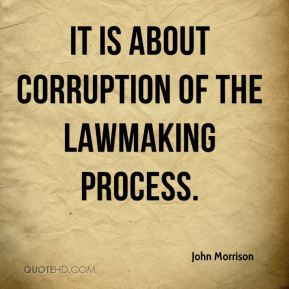 discussed in the news. But until recently, we didn’t hear much about how think tanks, fake news, astroturfing, and lies impact politics. Yet, their dominance over policies runs deeper than the D.C. swamp.
discussed in the news. But until recently, we didn’t hear much about how think tanks, fake news, astroturfing, and lies impact politics. Yet, their dominance over policies runs deeper than the D.C. swamp.
Think tanks got their name during the WWII era. They are non-governmental policy research organizations — or they are supposed to be.
“Think tanks conduct and recycle research that aims to solve policy problems and not solely to advance the theoretical debate.”
Maybe there has been a bit too much “recycling” of research.
Whether or not think tanks work as originally suggested, for “the common good,” comes into question particularly when money enters the equation. Remember, these are the groups in D.C. giving policy advice…during the lawmaking process. Where their money comes from does matter. Foreign powers buy influence at think tanks.
“Some scholars say they have been pressured to reach conclusions friendly to the government financing the research.”
Remember the old saying about computers? Garbage in, garbage out? By definition,
“poor quality input will always produce faulty output.”
Poor policy advice results in laws that do harm. Plus, many of the non-profit organizations that house think tanks do have outright political agendas. And too many people are not aware of the pre-determined plans of these organizations. As NPR wrote in What to Think About Think Tanks?,
“This has nothing to do with right-wing or left-wing politics. It has to do with giving the audience more – not less – information to help them evaluate the speaker.”
If think tanks are swayed by money and political ideology, are they producing “fake news”?
Where did fake news come from?
“Bending the truth for political gain is certainly nothing new – it’s propaganda, and the record of its uses stretch back to ancient times.”
“Propaganda and Internet fake news do, however, hold similarities: both are methods of distorting the truth for emotional persuasion, seeking to drive action.”
“Some claim that the term has now been co-opted by politicians and commentators to mean anything they disagree with – making the term essentially meaningless and more of a stick to beat the mainstream press with than a phenomenon in itself.”
I don’t see the term “fake news” as being meaningless. I see the danger of it —confusion in the public mind!
And when fake news is fortified by astroturfing, we shouldn’t be surprised that our country is failing to address problems with real solutions. The country can’t see the truth through all the lies.
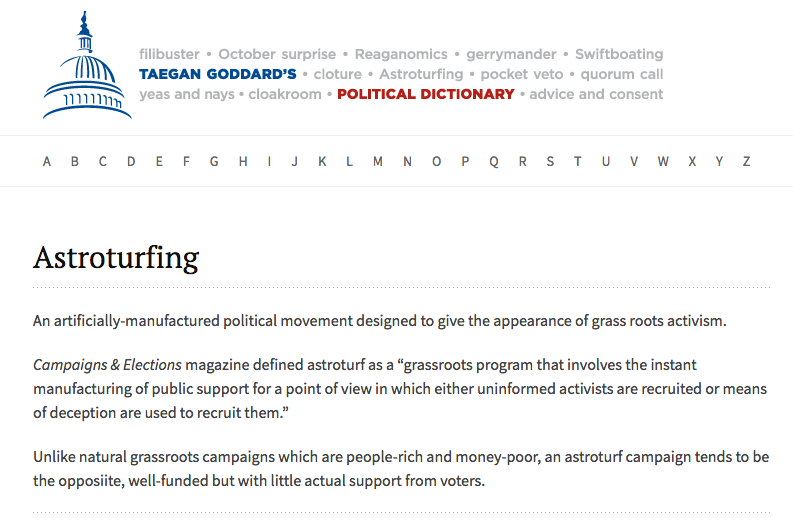 The corporate-elites controlling education policies in this country have been “buying and selling school reform” for decades (Hired Guns on Astroturf). How is a citizen supposed to know whom to believe? Even well-meaning activists are being deceived into working for policies they actually should be against. It isn’t the first time we People have been used, our tax-dollars used against us, or we have been lied to. … And there is no reason to believe we have seen the last of it.
The corporate-elites controlling education policies in this country have been “buying and selling school reform” for decades (Hired Guns on Astroturf). How is a citizen supposed to know whom to believe? Even well-meaning activists are being deceived into working for policies they actually should be against. It isn’t the first time we People have been used, our tax-dollars used against us, or we have been lied to. … And there is no reason to believe we have seen the last of it.
So that brings me to the main topic of Think Tanks, Fake News, Astroturfing, and Lies in the Era of Trump and DeVos.
I’ll use the charter school/voucher debate to demonstrate how the game is being played. This isn’t a new topic; it’s just finally on the national stage. The Trump White House is simply following in the footsteps of the previous three administrations when it comes to federal funding of charter schools….and expanding school choice HUGELY.
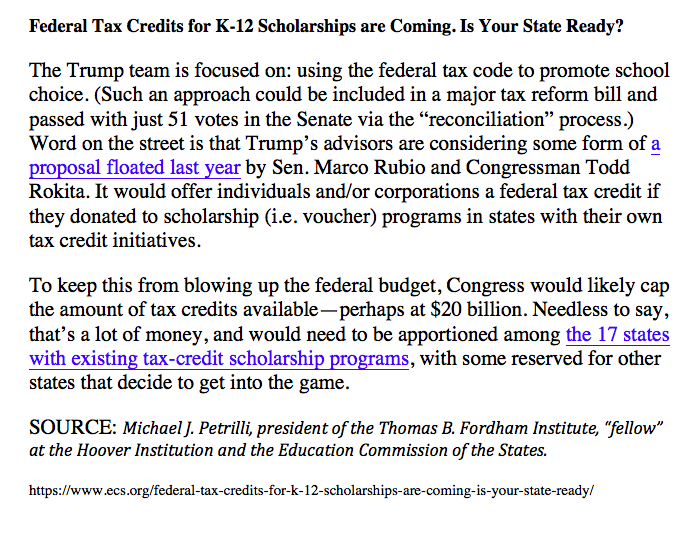
If the federal tax credits don’t appear in federal law, LOOK OUT for them to show up in your state! (Update: it went in federal law AND in 18 states.)
President Trump openly supports this expansion and Secretary of Education Betsy DeVos supports not only the Charter School (School Choice) Movement but is also pushing for public funds flowing to private schools through vouchers.…OR….by using the ALEC “scholarship” and “tax credit” laws already in place in several states.This is a school-choice tax credit plan that didn’t fly in 2013. But the plan is to get it done. The choice network thinks they can —with the help of 50CAN. Thankfully some parents across America are watching!
 To grow astroturf, you add more money and hire more people.
To grow astroturf, you add more money and hire more people.
What’s the harm? These billionaire-sponsored organizations have the capacity to control the news cycle. They can make things happen, or not, before most of us are even aware of what is happening. That level of domination of information doesn’t allow the real grassroots activists to prevail in blocking the corrupted lawmaking process at every turn. Too many twists and turns are an obstacle to citizen participation.
A disinformation campaign can quickly and easily be launched using both fake and legitimate, but naive, news outlets. In this example, here’s how things lined up then unraveled for the federal “opportunity” school-choice tax credits (thus far):
- End of April-First part of May —- Speaker of the House Paul Ryan pitched “Tax Reform.”
- Mid-May – a snag – A report was released by the American Association of School Administrators containing an analysis of tax credits.
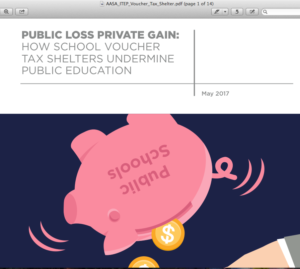 Then came the poor reception for the Trump budget.
Then came the poor reception for the Trump budget.
Things got messy for the think tanks. They should respect good research, solid evidence; right? Instead, the network went into control mode.
Between social media, the web of news outlets using think-tank experts for article and quotes, and the charter school networks, the disinformation campaign took off.
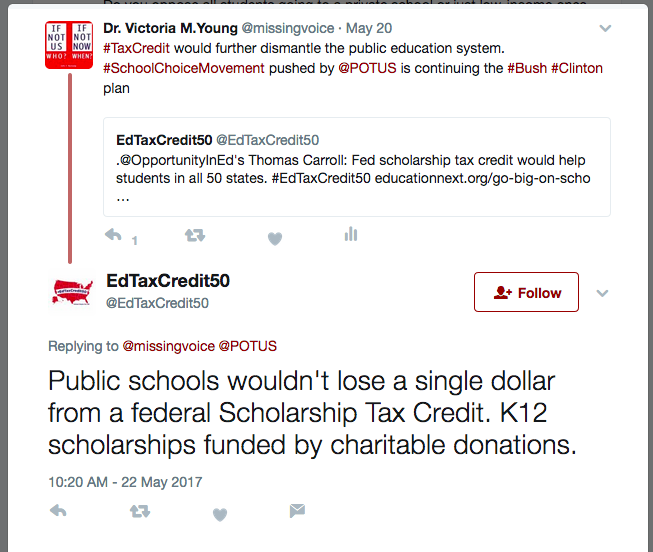
“School choice” laws facilitate the flow of funds to charter and private schools. The dollars follow the students, leaving existing schools without those dollars, even when chances are (based on research) the school of choice will be inferior. This tax credit IS a school choice law.
The public loses part of its tax base. The “charitable donor” (those with money to invest) makes money. Research says: public schools do lose money in this deal. Experts, what do they say? School Choice think tank experts like Rick (Frederick) Hess aren’t stupid. They want to cool down the chatter. They don’t want TrumpChoice to become a political battle anything like ObamaCare. Their propaganda campaign spread from D.C. to Idaho faster than a western wildfire.
They don’t want TrumpChoice to become a political battle anything like ObamaCare. Their propaganda campaign spread from D.C. to Idaho faster than a western wildfire.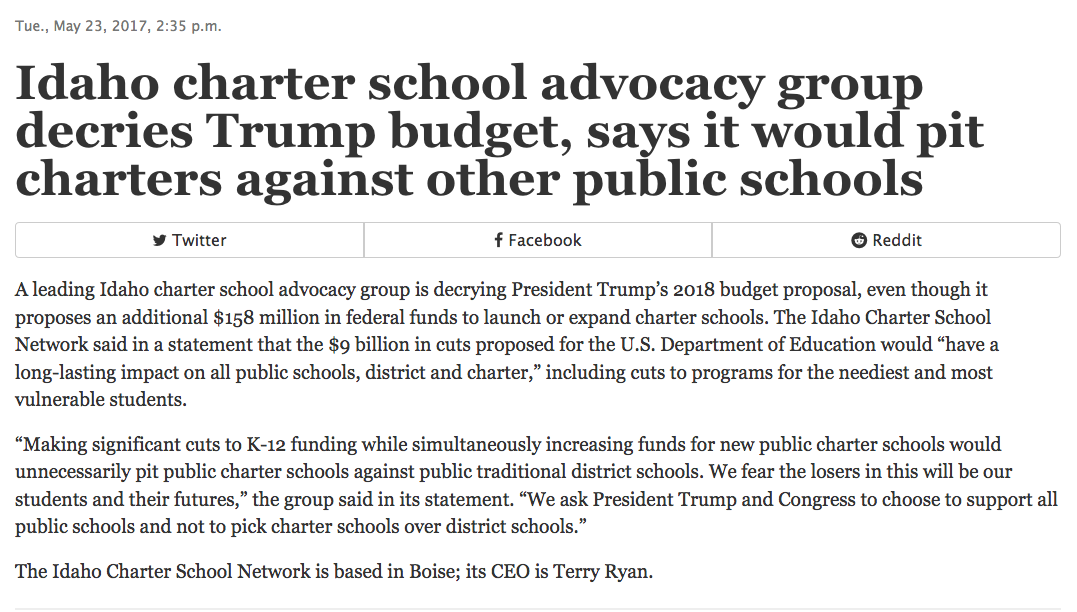 Sincere concern or propaganda? You decide. The choice network stands on the principle of “competition.” Consider this: Maybe it’s better to show the country how competition really “works” —right now, on the national stage—instead of waiting until no one is looking and let the Scholarship Tax Credits slip quietly into law.
Sincere concern or propaganda? You decide. The choice network stands on the principle of “competition.” Consider this: Maybe it’s better to show the country how competition really “works” —right now, on the national stage—instead of waiting until no one is looking and let the Scholarship Tax Credits slip quietly into law.
That is how The Quiet Revolution in American education reform has been waged and won —to date.
A general rule that has been followed is DO NOT ENGAGE. And for heaven’s sake, not on the main stage! Education reform was not supposed to be a major topic at the presidential level. Not really. The passage of the Every Student Succeeds Act just prior to the presidential campaign season helped ensure that what was wrong with No Child Left Behind would not be discussed. It still needs to be. The problems weren’t fixed.

This is how the rulers approached putting data collection systems in every state during the Great Recession. Where was the outrage? From a Best Practices Brief
http://nces.ed.gov/programs/slds/pdf/best_practices.pdf
So, IF the era of Trump and DeVos brings national conversations and debates about real problems, real solutions, and the news reports include perspectives from the real grassroots activists in the trenches of education reform, we might just drain the swamp ourselves.
Fight fire with fire. Engage.
P.S. I have always stood upon the principle of providing quality learning opportunities for all children through a publicly funded, publicly controlled public education system free from the corrupted forces of politics. If a hired gun wishes to have a civil conversation with me, wording questions in a way that sounds accusatory is not the way to do it. Putting words in my mouth? Wrong! That is a smear tactic. I’ll represent my own views, thank you.
I’ll represent my own views, thank you. 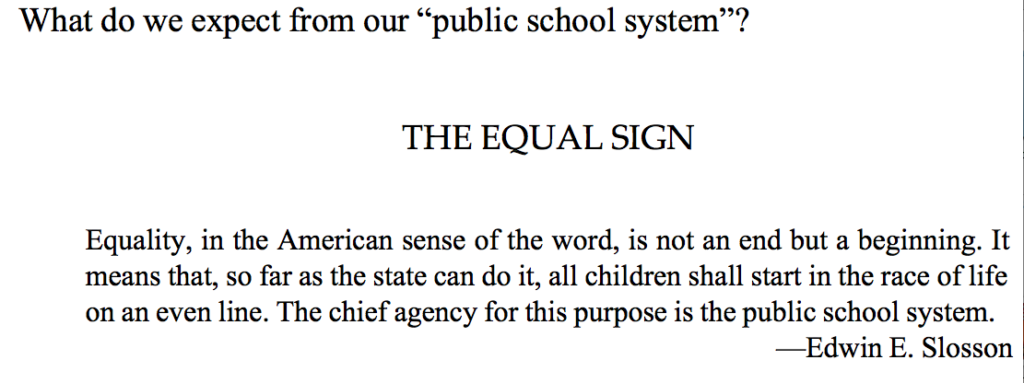
Education Lessons JFK Left Behind
100 years after the birth of John Fitzgerald Kennedy and with his birthday falling on Memorial Day, it seems fitting to look back in tribute at the education lessons JFK left behind.
President Kennedy recognized that our country
“requires a citizenry that understands our principles and problems. It requires skilled manpower and brainpower to match the power of totalitarian discipline. It requires a scientific effort which demonstrates the superiority of freedom. And it requires an electorate in every state with sufficiently broad horizons and sufficient maturity of judgment to guide this nation safely through whatever lies ahead.”
— Final Special Message to the Congress on Education, January 29, 1963
Today, are this nation’s needs any different than when JFK made his proposals to congress?
In 1961, Kennedy’s first appeal to Congress on behalf of public schools was for support of his “twin goals”:
“a new standard of excellence in education and the availability of such excellence to all who are willing and able to pursue it.”
By April 11, 1965, over two years after JFK’s assassination, his “twin goals” became the aim of national education policy when President Johnson signed the Elementary and Secondary Education Act (ESEA),
An Act
“To strengthen and improve educational quality and educational opportunities in the Nation’s elementary and secondary schools.”
Kennedy emphasized the need to address “depressed areas” and “slum neighborhoods” where children are known to have: poor diets, unaddressed speech, dental and visual disorders, and where older students are in need of job guidance and proper recreational activities.
The first titles of ESEA addressed Kennedy’s concerns for a spectrum of disadvantages:
Title I – Education of Children of Low Income Families to provide financial assistance to support educationally-deprived children.
Title II – School Library Resources, Textbooks, and Other Instructional Materials to provide for access to educational materials for all students in the State.
Title III – Supplementary Educational Centers and Services to provide services not currently offered but deemed vital to educational improvement made available to the entire community.
Kennedy stressed that unlike in the health and agricultural fields where they “have established the worth of systematic research and development,”
the education profession “lags behind in utilizing the results of research.”
To remedy the problem;
Title IV – Educational Research and Training; Cooperative Research Act to provide research, training, and dissemination of information aimed at improving the quality of teaching.
With variability in quality and access between the states recognized as a problem, ESEA’s last title clarified the intent of federal education law.
Title V – State Departments of Education aimed to stimulate and assist in strengthening the leadership resources of State educational agencies.
In each education-focused special message to Congress, JFK expounded further and further on how he saw the proper federal role. He declared,
“Let us put to rest the unfounded fears that ‘Federal money means Federal control.’” And he held up the Northwest Ordinance of 1787, the Morrill Act of 1862 (establishing the Land-Grant College system), and the National Defense Education Act of 1958 as examples where “the Congress has repeatedly recognized its responsibility to strengthen our educational system without weakening local responsibility.”
And the 35-page law, the 1965 ESEA, was completed with a statement limiting the boundaries of federal power:
“Federal Control of Education Prohibited
Nothing contained in this Act shall be construed to authorize any department, agency, officer, or employee of the United States to exercise any direction, supervision, or control over the curriculum, program of instruction, administration, or personnel of any educational institution or school system, or over the selection of library resources, textbooks, or other print or published instructional materials by any educational institution or school system.”
With the passage of ESEA, the major ideas that Kennedy and his advisers believed would strengthen and improve public schools were preserved — temporarily.
Today, both our federal boundaries and guiding principles are unclear.
So in memorial of President Kennedy’s birthday, May 29, 1917, let us recall how he wished to succeed in improving and strengthening educational opportunities for all the nation’s children.
Acknowledging that the quality of the students depends on…
“both the quality and the relative quantity of teachers and facilities,”
he emphasized class size, teachers’ salaries, and adequate classrooms as common problems particularly in need of assistance in states with limited financial resources.
Focusing on teachers, JFK felt…
“our immediate concern should be to afford them every possible opportunity to improve their professional skills and their command of the subjects they teach.”
He believed “teachers would profit from a full year of full-time study in their subject-matter fields. Very few can afford to do so.” The funding then proposed was to “begin to make such opportunities available to the elementary and secondary school teachers of this country and thereby accord to this profession the support, prestige and recognition it deserves.”
And quoting Thomas Jefferson,
“Let us keep our eye steadily on the whole system,”
Kennedy asked that his final education proposal “be considered as a whole, as a combination of elements designed to solve problems that have no single solution.”
The nations’ goals were to be met “on the basis of three fundamental guidelines:
- An appraisal of the entire range of educational problems…;
- A selective application of Federal aid – aimed at strengthening, not weakening, the independence of existing school systems and aimed at meeting our most urgent education problems and objectives…; and
- More effective implementation of existing laws…”
To honor limited federal involvement in education, the “appraisal” is a necessary first step because,…
federal “participation should be selective, stimulative and, where possible, transitional” and “the proper Federal role is to identify national education goals and to help local, state and private authorities build the necessary roads to reach those goals.”
Today, we will only be able to finish building the necessary roads by first removing the roadblocks.
We must look back and recognize that our country
“requires a citizenry that understands our principles and problems.”
Do citizens clearly understand the problems?
Are we standing on the right education reform principles?
Did “we” change our goals?
Improving schools requires we understand the problems, understand the principles, and set the right goals. That is the lesson left behind.
Consider this. President Kennedy’s twin goals were a force that led our nation well for decades. But the changes to the Elementary and Secondary Education Act (ESEA) over many more decades has taken us further from meeting those twin goals of quality and equality.
Congress lost its footing. They overstepped. And they landed on a very slippery slope.

Those “other purposes” included basing the “quality” of education and access to it firmly upon standards and the tests associated with those standards. School Choice Programs were put in under Title I. Transportation costs were not included.

By the 2001 Bush administration, the whole law (NO CHILD LEFT BEHIND) was clearly Outcome-Based with accountability for all schools under federal control, flexibility with spending our federal dollars out of control, and school choice included in a variety of places. It was in sections under parental involvement, accountability, and supplemental services. The funding to assess transportation costs as well as picking up that cost in certain cases were included.
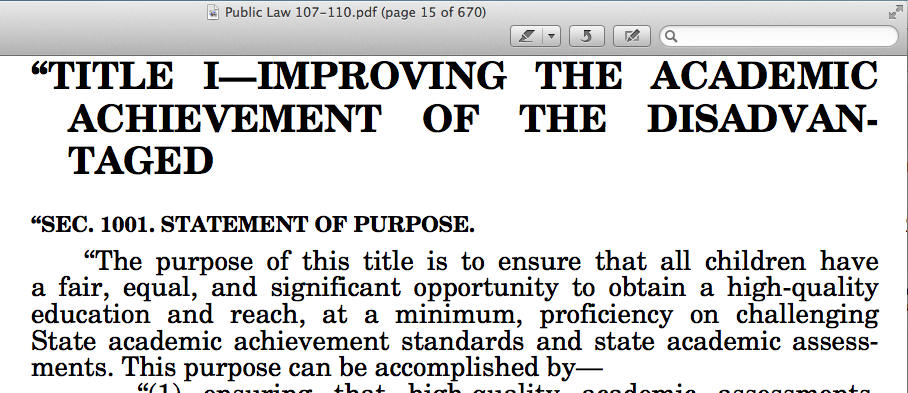
This is what NCLB Title I said ( “disadvantaged” ) but NCLB clearly had all public schools march to the same drummer – standards and testing – one-size-fits-all.

In a last-minute rush, the 2015 Obama administration signed into law the Every Student Succeeds Act. The law was renamed so many times in the year preceding the push that the public couldn’t keep up and the writers wrote “achieves” instead of “succeeds” in the final version. ESSA is not what the public was told it would be.

Title I officially has the federal government involved in the basic programs of all schools still based on the principles of NCLB with a ramping up of school choice at every turn, including pre-K charters, with the Secretary of Education given more power to start-up charters as well as providing the first year of transportation costs.
Don’t you think its time we all took a step back, stopped the federal overreach, and corrected the mistakes that have been made?
The education lessons JFK left behind for this nation provides us solid ground upon which to stand. That platform was built where practical knowledge of improvement practices met the need for equal access under the law.
I hope more of you will make the time to read and contemplate President Kennedy’s three messages to Congress on education (the only links in this blog). All real reformers should stand on the solid principles they provide before continuing to fight in the American education reform wars. That war is currently dividing the  nation along ideological and political lines while allowing the dismantling of a longstanding system that served us well.
nation along ideological and political lines while allowing the dismantling of a longstanding system that served us well.
Let us read, understand, remember, and use the education lessons JFK left behind.
Rural America in the Crosshairs: A New Frontier for Profiteers
This is my plea to rural America and to all the people who carried Mr. Trump into the White House. Please remember your power and use it well. Don’t let corporate interests ruin our American small-town way of life.
Preserving our public education system is at the heart of this battle. And the public can both preserve and improve our schools…Why close them or leave them behind?
This past election season should give us hope. In Massachusetts (the state that has proven that true education reform is possible), voters said “NO” to lifting the cap on charter schools. Why?
“…almost all of the fiercest Question 2 opponents were cities and towns whose public schools are losing money to charter schools.”
And as one principal expressed…
“Community members and parents I talk to want to fight for the resources to improve the public schools we already have rather than opening more schools.” He [Peter Bachli] added, “It’s as if the refrigerator light went out and instead of fixing it you bought a new refrigerator.”
Many people are considering the consequences of “school choice” as we now know it. Charters, school vouchers, and technology are the main products being sold to fill the gaps in education decisively created through our laws. Yes, the market was created.
To make a buck (or billions), the education industry under the guise of education reform has put a price on the heads of children — again and still. Urban markets were tapped first. Now, schools in rural America are in the crosshairs.
But rural America doesn’t have to go the way of America’s urban districts. Not if we learn from their experiences.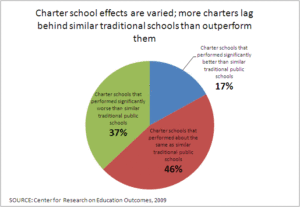
And here in Idaho, we can learn from other small towns that have all but been destroyed by our modern-day version of “school choice.”
My hometown of Albion, Michigan is a perfect example. Crippled economically by unfair competition leading to de-industrialization, families paid the price for “globalization” (a nice code word for the development of multinational corporate monopolies).
At the same time, the farce of test-based reforms in K-12 education fueled the development of school choice laws.
So with 80 percent of charter schools in Michigan being for-profit schools, the education industry profited at the expense of American small-town traditions. Gone were the Friday night football games. Gone were the Christmas programs. Gone were the opportunities to gather in local businesses after school events — because — gone were the schools. They were closed. Kids are bused elsewhere.
The fabric of the community was shredded.
Rural America, I’m not crying wolf. Rural schools ARE in the crosshairs of the education industry. The plan is well underway.
Step 1: Direct funding…
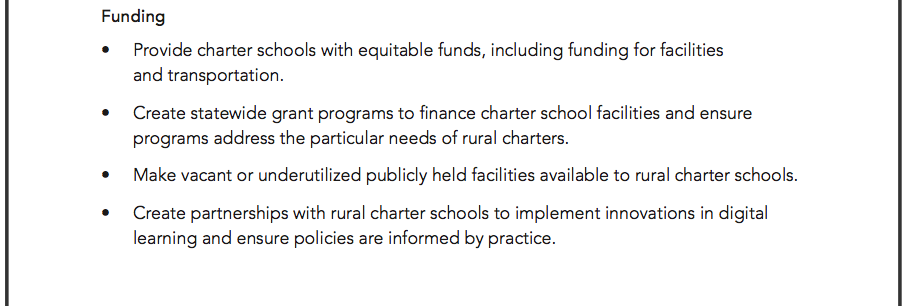
FROM A New Frontier: Utilizing Charter Schools to Strengthen Rural Education by Andy Smarick http://files.eric.ed.gov/fulltext/ED553987.pdf
Step 2: Get state law in line…

AND this opens the door for philanthropic venture capitalists. Those with an interest in “success” of these charters will use their money to ensure “effectiveness” can be demonstrated.
Step 3: Coordinate federal law …(while claiming more state and local control)…
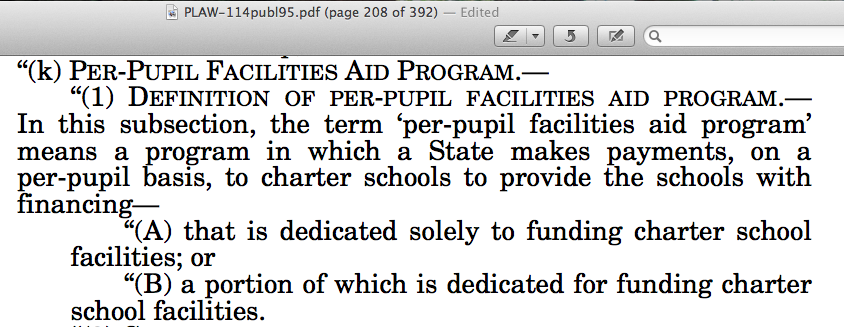
This is the Every Student Succeeds Act (ESSA Public LAW 114-95). Why does the federal government feel the need to tell states how to fund charter schools?
Step 4: “Grow-your-own” market even when that means you direct funds AWAY FROM IMPROVING SCHOOLS….really.

YES, this does say to FOREGO improvements. THIS IS ESSA. No Child Left Behind created a market in the same way. It limited curriculum while charters popped up offering more of what was removed from regular public schools.
The decades-long standards, assessment, accountability, and technology movement continues making “choice” a moneymaking instrument easily sold to freedom-loving people.
For Idaho this began in the 1990’s with the Albertson Foundation sponsoring the development of “new” standards. Then came the assessments and accountability mechanisms to spawn competition between schools thus creating a market for “choice.” They focused their money and our laws (and money) on standards and testing for math and reading at the expense of better quality education. Their vision. Their plan. Their lobbyists that created “our” laws that in turn foot the bill for education products to fix what they helped ruin.
Now, they have much of Idaho believing we don’t understand “what policies and practices are likeliest to help” improve our rural schools. That simply is not true.
In January of 2013, one conclusion of state research was that our rural schools wanted their teachers to have the opportunity to obtain multiple certifications. Administrators wanted to improve the quality of their teaching workforce.
Instead, in August of 2013, the Albertson Foundation brought in out-of-state experts to examine OUR rural schools.
They found a new frontier — for rural charter schools — based on “the fantastic work done by charter management organizations” and “human capital organizations” like The New Teacher Project…..Wait? Who?
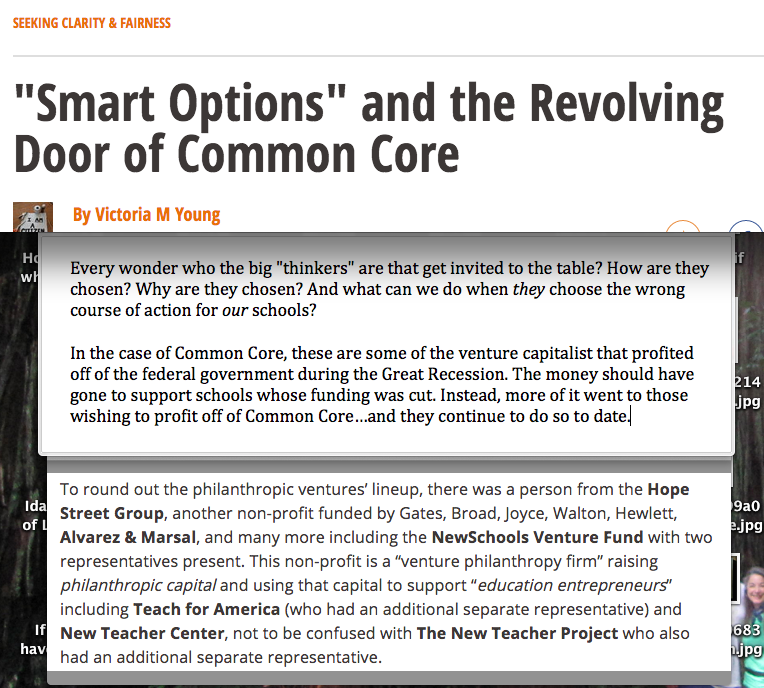 Let’s be clear. We are talking about philanthropic venture capitalists. These are the same people who put their money (and ours) on Common Core.
Let’s be clear. We are talking about philanthropic venture capitalists. These are the same people who put their money (and ours) on Common Core.
You think Common Core is simply going away because Mr. Trump doesn’t like it? Not when those who teach the teachers, develop the leadership, and lobby the lawmakers are in control. The Common Core System is in place. With the change of a name, in the blink of an eye, we still face the same problem of no real local control. Charter schools are not the answer to that problem.
And there seems to be a belief that charters will only come in where they are needed and wanted. Can the public just say no and have it be so? Ask congress.

In Idaho, our state board has the POWER also. Idaho’s State Board is not elected; they are selected!
So knowing how the laws have been fixed to profit the charter industry, as I traveled across rural Idaho over the Thanksgiving weekend, I tried not to think about it. But unfortunately while passing through one small town in particular, a horrible thought struck me. How long would it be before the food chain consisted of ConAgra, Monsanto, and Walmart?
And what will the schools be like under this new world order? Well, if the purpose of education is workforce development, we know who’ll be calling the shots.
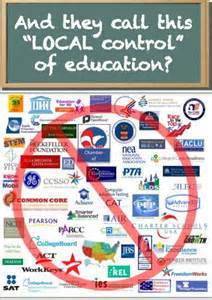 On the other hand, I’m not convinced that corporate America will trump rural America.
On the other hand, I’m not convinced that corporate America will trump rural America.
Will America be made great again by those who control the schools?
Will rural America choose to give control to the same people who manipulate our laws to benefit their industry?
Or will rural Americans reclaim the “new frontier” as their own?
How will we see success?

Crosshairs added with the help of a friend. Photo from Harvesting Success: Charter Schools in Rural America brought to us by the “National” Charter School Resource Center and SAFAL partners (a consulting firm with “deep domain knowledge in the charter section, human capital management systems, and next generation learning.”….Rural America, are these the people you want managing your children and grandchildren?
“Let’s have faith that right makes might; and in that faith let us, to the end, dare to do our duty as we understand it.” — Abraham Lincoln
P.S. Special thanks to the undistinguished Americans that go unacknowledged for the extraordinary research they selflessly do everyday (without pay) in an attempt to enlighten all of us. I for one appreciate their contributions to this blog.

